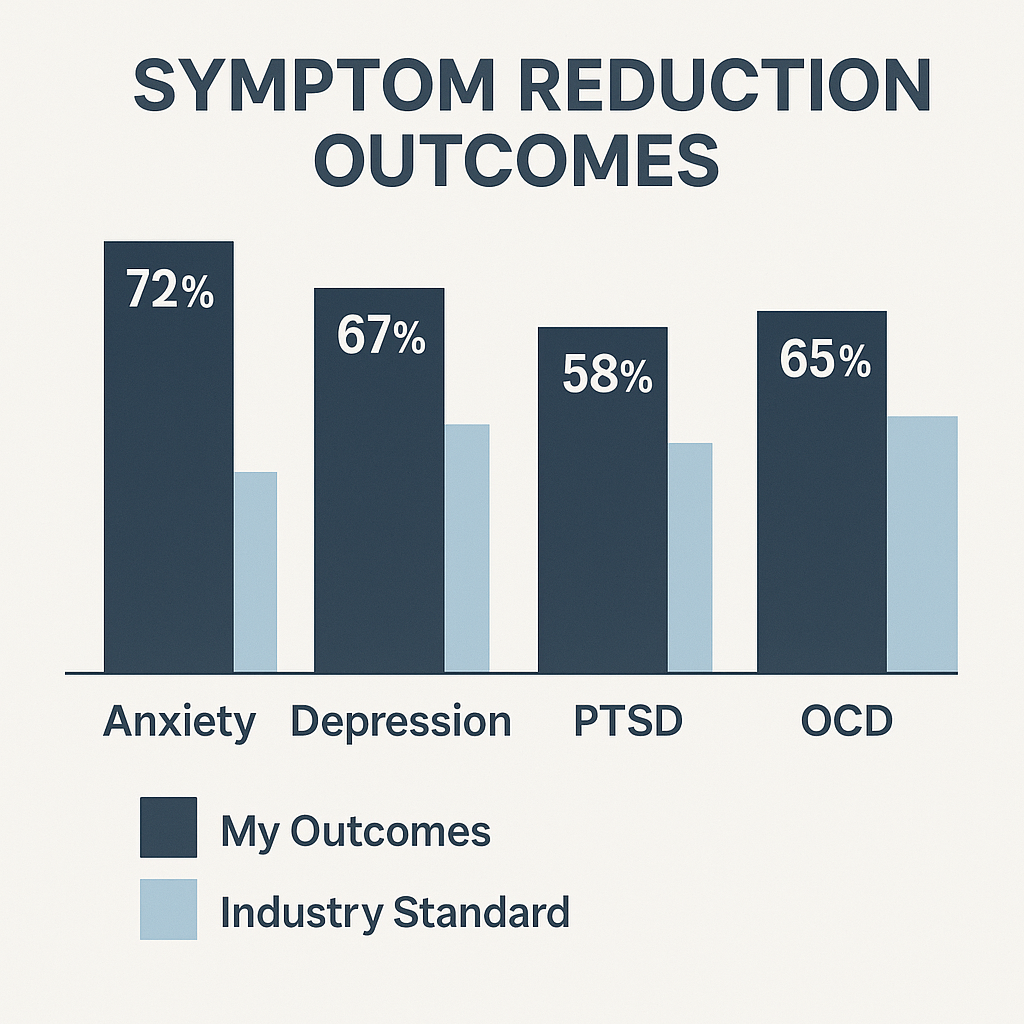How Effective Is Therapy? My Symptom Reduction Outcomes vs. Industry Standards
When people look for a therapist, one of the most important questions they quietly ask themselves is: Does therapy actually work? And will it work for me?
I take this question seriously. Every year, I track real client progress using validated clinical measures across anxiety, depression, PTSD, and OCD—the conditions I treat most often.
Below is a breakdown of my most recent outcome data, compared to industry standards across the United States:
Why These Numbers Matter
Across the mental health field, symptom reduction rates typically fall between 30–45% for most conditions. These averages include every type of therapy—from supportive counseling to evidence-based care.
My practice primarily uses evidence-based therapies such as:
CBT (Cognitive Behavioral Therapy)
ERP (Exposure & Response Prevention)
ACT (Acceptance & Commitment Therapy)
CPT (Cognitive Processing Therapy)
DBT-informed skills for emotion regulation
These modalities are considered “gold standard” treatments because they consistently outperform traditional talk therapy. And in a private, individualized setting, clients often make faster gains.
The Data: How My Clients Improve
Anxiety – 72% Reduction (vs. ~40% industry standard)
Clients struggling with generalized anxiety, panic symptoms, worry spirals, and physical tension consistently see significant improvement. ERP, CBT, and exposure-based strategies help retrain the brain to interpret sensations and thoughts with less fear.
Depression – 67% Reduction (vs. ~35–40% industry standard)
Using structured behavioral activation, cognitive restructuring, and skill-building, clients often regain motivation, re-engage with daily life, and see measurable mood improvement within the first 6–10 weeks.
PTSD – 58% Reduction (vs. ~35% industry standard)
CPT and trauma-focused interventions help clients process past experiences without reliving them. Reductions include fewer intrusive memories, improved sleep, less avoidance, and better overall functioning.
OCD – 65% Reduction (vs. ~35–40% industry standard)
With ERP—the most effective treatment for OCD—clients dramatically reduce compulsions, reassurance-seeking, checking, avoidance, and intrusive thought loops. Many clients describe ERP as “life-changing.”
What Makes These Outcomes Possible?
1. Highly Structured, Evidence-Based Treatment
No vague “talking in circles.” Every session has a purpose, a skill, a plan, and a measurable goal.
2. Personalized Treatment Plans
No two clients have the same brain, same history, or same triggers. Therapy is customized—not templated.
3. Real Tracking + Continuous Adjustment
Clients regularly complete symptom assessments so we can adjust treatment in real time, not guess.
4. A Coaching-Oriented, Practical Approach
I teach clients the tools they need to function independently—skills they will use for life.
What This Means for You
If you’re dealing with anxiety, depression, OCD, PTSD, or chronic stress, there is a path forward—and the data shows it works.
Therapy should help you:
Feel more in control of your mind
Break habits that keep anxiety looping
Improve sleep, energy, and daily stability
Reduce intrusive thoughts and compulsions
Get back to the life you want to live
Real therapy leads to real change—and the numbers prove it.
If You’re Ready to Start Feeling Better
I offer same-week openings for adults and teens via telehealth or in-person sessions in Westmont, and I serve surrounding areas including Hinsdale, Clarendon Hills, Downers Grove, Oak Brook, Elmhurst, and the broader Chicagoland suburbs.
If you’d like to learn more or schedule an appointment, feel free to reach out anytime.


